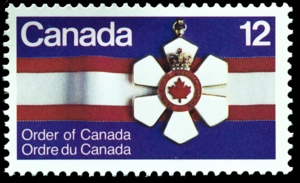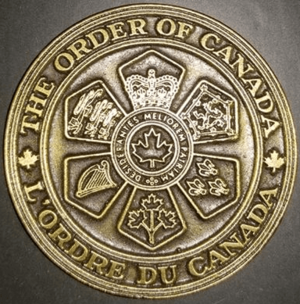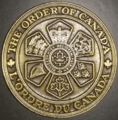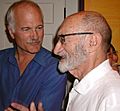Order of Canada facts for kids
Quick facts for kids Order of CanadaOrdre du Canada |
|
|---|---|

Insignia of a Member
|
|
| Awarded by the Crown of Canada |
|
| Type | National order |
| Established | 17 April 1967 |
| Motto | Desiderantes meliorem patriam (Latin for 'They desire a better country') |
| Eligibility | All living Canadians, except federal and provincial politicians and judges while holding office |
| Criteria | The highest degree of merit, an outstanding level of talent and service, or an exceptional contribution to Canada and humanity |
| Status | Currently constituted |
| Founder | Elizabeth II |
| Sovereign | Charles III |
| Chancellor and Principal Companion | Mary Simon, Governor General of Canada |
| Grades |
|
| Former grades |
|
| Statistics | |
| First induction | 1 July 1967 |
| Total inductees | 8,647 (as of July 2025[update]) |
| Precedence | |
| Next (higher) | Member of the Order of Merit |
| Next (lower) | Commander of the Order of Military Merit |
The Order of Canada (French: Ordre du Canada) is a very important Canadian honour. It is the second-highest award for special achievements in Canada. This award is given to people who have made a big difference to Canada and the world.
The Order was created in 1967, when Canada celebrated its 100th birthday. It has three levels: Companion, Officer, and Member. People who receive this award show the Order's Latin motto, desiderantes meliorem patriam. This means "they desire a better country." This phrase comes from an old book called Hebrews 11:16.
The King or Queen of Canada is the leader of the Order. The Governor General of Canada helps manage the Order. A special group recommends people for the award. The Governor General then officially welcomes them. As of July 2025, 8,647 people have received this honour. These include scientists, musicians, athletes, and artists. Some people have left the Order, and some appointments have caused discussion.
Contents
History of the Order of Canada
The idea for the Order of Canada started in 1966. Queen Elizabeth II officially created it on April 17, 1967. This was done with advice from the Canadian Prime Minister, Lester B. Pearson. The snowflake design for the award was suggested by a diplomat named John G. H. Halstead.
The Order officially began on July 1, 1967. This was Canada's 100th anniversary. The first person to be inducted was Governor General Roland Michener. A few days later, 90 more people were appointed. These included important Canadians like former Prime Minister Louis St. Laurent and painter Arthur Lismer.
The Order of Canada helped create a unique Canadian honours system. This meant Canada started using fewer British awards. The Order of Canada is one of the top civilian awards in Canada. In 2023, Canadian historian Margaret MacMillan represented the Order at the coronation of King Charles III.
Levels of the Order of Canada
The King or Queen of Canada is the highest leader of the Order. The Governor General is the second-highest leader. After them, there are three main levels:
- Companion (CC)
- Officer (OC)
- Member (CM)
Each level has special letters that members can use after their name. The Governor General becomes a Principal Companion while in office. They remain an extraordinary Companion afterwards. Members of the Canadian Royal Family can also be appointed as extraordinary Companions, Officers, or Members. People can be promoted to a higher level, but usually not within five years of their first appointment.
The Order of Canada first had two levels: Companion and the Medal of Service. There was also a Medal of Courage, but it was never given out. In 1972, the Medal of Courage was replaced by the Cross of Valour. At the same time, the Officer and Member levels were added. This completed the three-level structure that Lester Pearson had imagined.
Companions of the Order (CC)
Companions show the highest level of achievement for Canada and the world. Up to 15 Companions can be appointed each year. There is a limit of 180 living Companions at any time. This does not include extraordinary or honorary Companions. As of August 2017, there were 146 living Companions.
Officers of the Order (OC)
Officers show outstanding talent and service to Canadians. Up to 64 Officers can be appointed each year. There is no limit to how many Officers can be living at one time. As of August 2017, there were 1,049 living Officers.
Members of the Order (CM)
Members have made a special contribution to Canada or Canadians. This is often at a local or regional level. Up to 136 Members can be appointed each year. There is no limit to how many Members can be living at one time. As of August 2017, there were 2,281 living Members.
What the Insignia Looks Like
 |
||
|---|---|---|
| Ribbon bar | ||
| Companion | Officer | Member |
When people join the Order of Canada, they receive special badges. These were designed by Bruce W. Beatty. The King's badge is made of gold with jewels like rubies and sapphires. It has a white snowflake design with a maple leaf in the middle.

The badges for members look similar but do not have precious stones.
- Companions have a red maple leaf in the middle.
- Officers have a gold maple leaf.
- Members have a silver maple leaf.
All badges have a small crown on top, showing the King is the head of the Order. The back of the badge simply says "CANADA."
The ribbon for the Order is white with red stripes, like the Canadian flag. There is also a small pin that members can wear on their clothes for less formal events. This pin is a tiny version of their badge.
Members wear their badges in a specific way. They are worn before most other Canadian awards. Companions and Officers wear their badges on a ribbon around their neck. Members wear theirs on a ribbon pinned to their left chest. Women can choose to wear their badge on a ribbon bow on their left shoulder or in the same way as men.
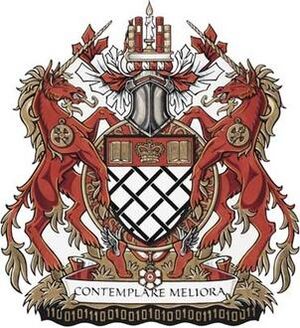
Members of the Order can also add the Order's motto and badge to their personal coat of arms. This is a special design that represents their family or achievements.
Keeping and Selling Insignia
The rules of the Order of Canada say that the badges belong to the Crown (the King or Queen). If a member is promoted to a higher level, they must return their old badge. While badges can be passed down in families or given to museums, they are not supposed to be sold. However, some badges have been sold over the years. For example, a Medal of Service badge was put up for sale online in 2007.
Who Can Be Appointed?
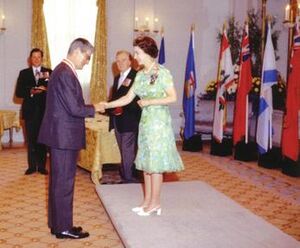
Any living Canadian citizen can be considered for the Order of Canada. However, federal and provincial politicians and judges cannot be appointed while they are in office. The Order recognizes people who have made a big difference to Canada through their life's work. It also recognizes non-Canadians who have helped make the world better.
Each year, hundreds of nominations are sent in. A special group called the Advisory Council reviews these nominations. They decide who is worthy of the award. The Governor General then makes the final choice. New members are usually welcomed at a ceremony at Rideau Hall. This is the official residence of the Governor General.
Members of the Order of Canada have also received other awards. For example, they automatically received the Queen Elizabeth II Silver Jubilee Medal in 1977 and the Queen Elizabeth II Diamond Jubilee Medal in 2012.
The Advisory Council
The Advisory Council's job is to look at the nominations and recommend new members to the Governor General. The Chief Justice of Canada leads this council. Other members include important government officials and leaders from arts and education groups. If a non-Canadian is nominated, the Deputy Minister of Foreign Affairs is asked for their opinion. New appointments are announced publicly.
As of July 2024, the members of the advisory council include:
- Richard Wagner, Chief Justice of Canada (Chair)
- Ewan Affleck
- Susan Aglukark
- John Hannaford, Clerk of the Privy Council
- Sharon Davis-Murdoch
- Marie Yvonne Delorme
- Stephanie Dixon
- Alain-G. Gagnon, President of the Royal Society of Canada
- Daniel Germain
- Karina LeBlanc
- Isabelle Mondou, Deputy Minister of Canadian Heritage
- Deep Saini, Chair of Universities Canada
- Jesse Wente, Chair of the Canada Council for the Arts
Declining the Honour
Not many people have turned down the Order of Canada. The names of those who decline are usually kept private. However, some have spoken about their choice. For example, Robert Weaver did not like that the Order had three levels. Prince Philip, Duke of Edinburgh, first declined an honorary appointment. He felt that as the Queen's husband, he was Canadian and should receive a full appointment. He later accepted an appointment as the first extraordinary Companion in 2013.
Leaving the Order
Members can resign from the Order by writing a letter to the Secretary General. The Governor General must approve the resignation. For example, in 2009, astronomer René Racine resigned.
Members can also be removed from the Order if their actions bring shame to it. The Advisory Council must agree to remove someone. The person is told of the decision and asked to respond. Anyone removed must return their insignia. As of February 2025, nine people have been removed from the Order of Canada. For example, Alan Eagleson was removed after being jailed. Conrad Black was also removed after being found guilty of fraud.
In 2013, Norman Barwin resigned from the Order. This happened because the Advisory Council was moving to remove him due to professional misconduct. In 2021, the Advisory Council considered removing Julie Payette, a former Governor General. She resigned from her role due to allegations of workplace harassment.
Discussions and Changes
Sometimes, appointments to the Order have caused public discussion. For example, the appointment of Henry Morgentaler in 2008 was very controversial. People who disagreed with his work protested.
In 2006, experts discussed if the three levels of the Order were enough to recognize Canada's very best. One idea was to add two more levels. In 2010, it was suggested that a new special division of the Order could be created for Governors General and members of the Royal Family. A version of this idea was adopted in 2013.
Images for kids
-
Lorne Michaels wearing the lapel pin of a Member
-
The coat of arms of David Johnston, former Governor General of Canada and Chancellor and Principal Companion of the Order of Canada, displaying the order's motto and insignia
-
Elizabeth II, Queen of Canada and Sovereign of the Order of Canada, invests Jules Léger as a Companion of the order at Rideau Hall, August 1973.
-
Prince Philip, Duke of Edinburgh, wearing at the neck the insignia of a Companion of the Order of Canada.
-
Henry Morgentaler (right), with Jack Layton (left); Morgentaler's appointment was one of the most controversial in the history of the Order of Canada.
See also
 In Spanish: Orden de Canadá para niños
In Spanish: Orden de Canadá para niños
- List of companions of the Order of Canada
- Canadian order of precedence (decorations and medals)


